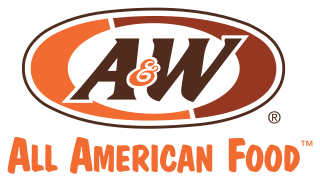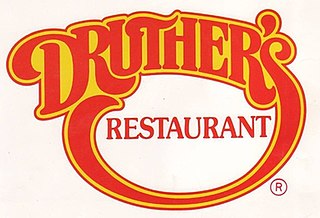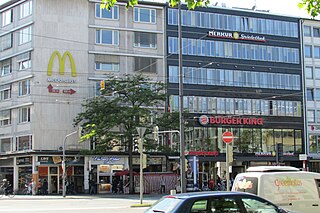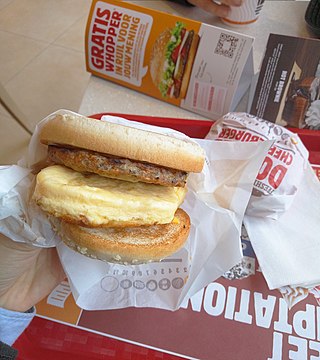Burger King is a major international fast food restaurant chain and corporation.
Burger King may also refer to:

A hamburger, or simply a burger, is a dish consisting of fillings—usually a patty of ground meat, typically beef—placed inside a sliced bun or bread roll. The patties are often served with cheese, lettuce, tomato, onion, pickles, bacon, or chilis with condiments such as ketchup, mustard, mayonnaise, relish or a "special sauce", often a variation of Thousand Island dressing, and are frequently placed on sesame seed buns. A hamburger patty topped with cheese is called a cheeseburger. Under some definitions, and in some cultures, a burger is considered a sandwich.

A fast-food restaurant, also known as a quick-service restaurant (QSR) within the industry, is a specific type of restaurant that serves fast-food cuisine and has minimal table service. The food served in fast-food restaurants is typically part of a "meat-sweet diet", offered from a limited menu, cooked in bulk in advance and kept hot, finished and packaged to order, and usually available for take away, though seating may be provided. Fast-food restaurants are typically part of a restaurant chain or franchise operation that provides standardized ingredients and/or partially prepared foods and supplies to each restaurant through controlled supply channels. The term "fast food" was recognized in a dictionary by Merriam–Webster in 1951.

Burger King Corporation is an American multinational chain of hamburger fast food restaurants. Headquartered in Miami-Dade County, Florida, the company was founded in 1953 as Insta-Burger King, a Jacksonville, Florida–based restaurant chain. After Insta-Burger King ran into financial difficulties, its two Miami-based franchisees David Edgerton (1927–2018) and James McLamore (1926–1996) purchased the company in 1959. Over the next half-century, the company changed hands four times and its third set of owners, a partnership between TPG Capital, Bain Capital, and Goldman Sachs Capital Partners, took it public in 2002. In late 2010, 3G Capital of Brazil acquired a majority stake in the company in a deal valued at US$3.26 billion. The new owners promptly initiated a restructuring of the company to reverse its fortunes. 3G, along with its partner Berkshire Hathaway, eventually merged the company with the Canadian-based doughnut chain Tim Hortons under the auspices of a new Canadian-based parent company named Restaurant Brands International.

Jollibee is a Filipino chain of fast food restaurants owned by Jollibee Foods Corporation (JFC) which serves as its flagship brand. Established in 1978 by Tony Tan Caktiong, it is the Philippines' top fast food restaurant and is among the world's fastest growing restaurants, expanding its international presence from 2014 to 2024 almost sixfold. As of January 2024, there were over 1,668 Jollibee fast-food branches across 17 countries, with restaurants in Southeast Asia, East Asia, the Middle East, North America, and Europe. Jollibee is best known for its bestselling item, the Chickenjoy.

A&W Restaurants, Inc. is an American fast food restaurant chain distinguished by its "Burger Family" combos, draft root beer and root beer floats. A&W's origins date back to 1919 when Roy W. Allen set up a roadside drink stand to offer a new thick and creamy drink, root beer, at a parade honoring returning World War I veterans in Lodi, California. Allen's employee Frank Wright partnered with him in 1922 and they founded their first A&W restaurant in Sacramento, California in 1923. The company name was taken from the initials of their last names – Allen and Wright. The company became famous in the United States for its "frosty mugs" – the mugs were kept in a freezer and filled with A&W Root Beer just before being served to customers.

Hungry Jack's Pty Ltd. is an Australian fast food franchise of the Burger King Corporation. It is a wholly owned subsidiary of Competitive Foods Australia, a privately held company owned by Jack Cowin. Hungry Jack's owns and operates or sub-licenses all of the Burger King/Hungry Jack's restaurants in Australia.

Burger Chef was an American fast-food restaurant chain. It began operating in 1954 in Indianapolis, Indiana, expanded throughout the United States, and at its peak in 1973 had 1,050 locations, including some in Canada. The chain featured several signature items, such as the Big Shef and Super Shef hamburgers.

The Burger King is a king character used as the primary mascot for the fast-food restaurant chain of the same name. The first iteration of the Burger King was part of a sign at the first Burger King restaurant in Miami, Florida, in 1955. Later signs showed the King sitting on a "burger throne" as well as atop the BK sign while holding a beverage. In the early 1970s, Burger King started using a small and animated version of the King in its children's advertising, voiced by Allen Swift. In 1976, the original animated King was replaced by the "Marvelous Magical Burger King" which was a red-bearded and Tudor-era king who ruled the Burger King Kingdom and performed magic tricks that were mostly sleight-of-hand but sometimes relied on camera tricks or involved his "Magic Ring" which could summon copious amounts of food. The Burger King Kingdom advertisements were discontinued in the late 1980s in favor of the BK Kids Club Gang and other advertising programs.

Carrols Restaurant Group, Inc. is an American franchisee company and is the largest Burger King franchisee in the world; Carrols owns and operates over 1,000+ Burger Kings, and 55 Popeyes restaurants. The company has operated Burger Kings since 1976 in locations across 23 U.S. states.

A&W is a fast-food restaurant chain in Canada, franchised by A&W Food Services of Canada, Inc.

Druther's is a restaurant, formerly a chain of fast food restaurants that began as Burger Queen restaurants started in Winter Haven, Florida in 1956, and then based in Louisville, Kentucky from 1963 until 1981. The name was a play on the word "druthers", and the mascot was a giant female bee named Queenie Bee. In 1981, Burger Queen changed to Druther's restaurants, although the changes were mostly cosmetic. One reason given for the name change was to eliminate the perception that they specialized in only hamburgers when they also had fried chicken and a serve-yourself salad bar. Druther's featured a character named "Andy Dandytale" on its kids meal items. The chain's slogan was "I'd Ruther Go to Druther's Restaurant." As of April 2024, the company operates 1 location in Kentucky.
As far back as the 1970s, international fast food restaurant chain Burger King has attempted to introduce a premium line of burgers. These sandwiches are part of a system which eventually became known as the barbell strategy; a plan designed to expand Burger King's menu with both more sophisticated, adult-oriented fare along with products that are more value-oriented. This program is intended to bring in a larger, more affluent adult audience who will be willing to spend more on the better quality products on one side while maintaining a lower cost value menu dedicated to a more cost-conscious audience on the other. The hope is that the customers would be drawn in initially for the lower prices of the value-menu and upgrade to the more expensive products, upping overall sales.

When the predecessor of international fast food restaurant chain Burger King (BK) first opened in 1953, its menu predominantly consisted of hamburgers, French fries, soft drinks, milkshakes, and desserts. After being acquired by its Miami, Florida franchisees and renamed in 1954, BK began expanding its menu by adding the Whopper sandwich in 1957, and has since added non-beef items such as chicken, fish, and vegetarian offerings, including salads and meatless sandwiches. Other additions include a breakfast menu and beverages such as Icees, juices, and bottled waters. As the company expanded both inside and outside the United States, it introduced localized versions of its products that conform to regional tastes and cultural or religious beliefs. To generate additional sales, BK occasionally introduces limited-time offers of special versions of its products, or brings out completely new products intended for either long- or short-term sales. Not all of these products and services have been successful; in 1992, Burger King introduced limited table service featuring special dinner platters, but this concept failed to generate interest and was discontinued.

The Burger wars are a series of off-and-on comparative advertising campaigns consisting of mutually-targeted advertisements that highlight the intense competition between hamburger fast food chains McDonald's, Wendy's, Burger King and others in the United States. The term first came into use during the late 1970s due to an attempt by Burger King to generate increased market and mind-share by attacking the size of bigger rival McDonald's hamburgers.

Originally just a ground beef patty, as it is still interpreted in multiple languages, the first hamburger likely originated in Hamburg (Germany), hence its name; however, evidence also suggests that the United States may have later been the first country where two slices of bread and a ground beef patty were combined into a "hamburger sandwich" and sold as such. Shortly after this combination, the hamburger quickly included all of its currently typically characteristic trimmings, including onions, lettuce, and sliced pickles.

The fast-food restaurant chain Burger King was the first major fast food chain to introduce a grilled chicken burger to the marketplace, in 1990, six months before Wendy's and four years before McDonald's. Since then, Burger King, and its Australian franchise Hungry Jack's have offered a variety of grilled chicken burgers, as have Wendy's and McDonald's.

International fast-food restaurant chain Burger King and its Australian franchise Hungry Jack's have had a variety of breakfast sandwiches in their product portfolio since 1978. The Croissan'wich was the first major breakfast sandwich product introduced by the company.